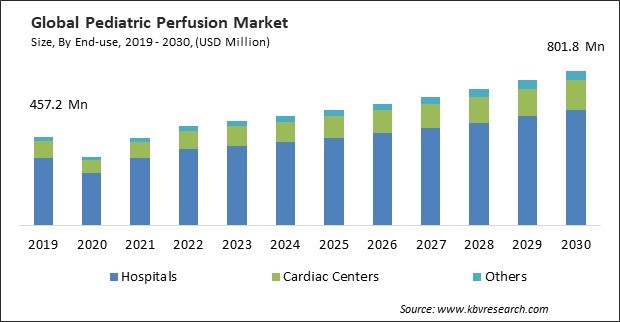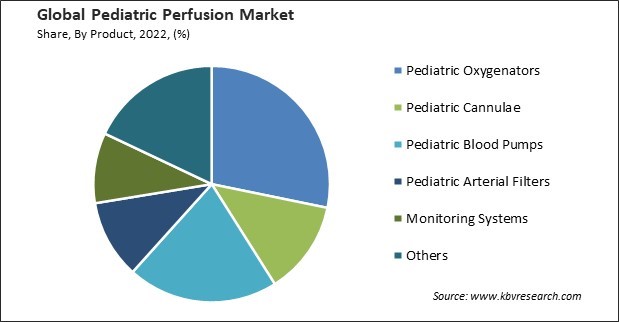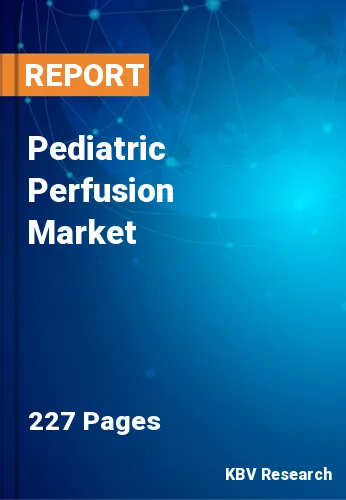The Global Pediatric Perfusion Market size is expected to reach $801.8 million by 2030, rising at a market growth of 5.8% CAGR during the forecast period.
The Children's Hospital Graduate Medical Education (CHGME) Program and National Congenital Heart Disease Action Plan have aided in increasing the awareness of CHD in newborns. Therefore, Hospitals segment generated $3,95.1 million revenue in the market in 2022. As a result, the CHGME program also provides federal funding to children's hospitals for graduate medical education. It supports the training of pediatric perfusionists and healthcare professionals specializing in pediatric cardiac care. Some of the factors impacting the market are rising R&D and multidisciplinary approach towards patient care, increasing incidence of congenital heart defects and limited accessibility to specialized care.

The positive impact of a multidisciplinary approach is further complemented by ongoing research and development in the field. Research initiatives aim to explore new techniques, technologies, and best practices that can enhance the safety and efficacy of pediatric perfusion. These efforts have led to the creation of more advanced and efficient perfusion equipment and techniques, driving further growth in the market. Additionally, CHDs are structural heart abnormalities that are present at birth and often require surgical intervention, making pediatric perfusion services a crucial component of the care provided to these young patients. According to the National Library of Medicine, the birth prevalence of CHD varies among studies worldwide and is mostly reported between 8 and 12 per 1000. Therefore, all these aforementioned factors will aid in the expansion of the market in the coming years and the combined effect of these factors has transformed the landscape of pediatric cardiac care, with pediatric perfusionists playing a central role in ensuring the well-being of children with congenital heart defects.
However, the scarcity of healthcare resources and personnel, such as pediatric perfusionists and specialized perfusion equipment, also plays a detrimental role in accessibility. In regions with limited resources, there may be fewer available appointments for pediatric cardiac surgeries and perfusion services, leading to prolonged wait times. This not only affects the quality of care but also increases stress and uncertainty for families. Moreover, the shortage of specialized resources can place a strain on healthcare providers, further hampering the market's growth potential.
Additionally, the strain on healthcare resources due to the pandemic, such as the allocation of staff and equipment to COVID-19 care, had negative implications for non-COVID-related healthcare, including pediatric cardiac care. Some pediatric cardiac surgeries and procedures were delayed or rescheduled, impacting the scheduling and workloads of perfusionists. Some healthcare facilities experienced a reduction in patient volumes during the pandemic due to concerns about virus transmission and lockdown measures. This reduced patient volume led to decreased demand for these services and equipment.
Based on product, the market is divided into pediatric oxygenators, pediatric cannulae, pediatric blood pumps, pediatric arterial filters, monitoring systems, and others. The monitoring systems segment procured a promising growth rate in the market in 2022. By prioritizing patient safety and taking advantage of technological advancements, the pediatric perfusion monitoring systems segment drives growth by offering real-time data along with feedback during cardiac surgeries. The segment's growth is attributed to the growing number of heart surgeries, regulatory standard compliance, and the growing need for continuous monitoring.

On the basis of end-use, the market is segmented into hospitals, cardiac centers, and others. The cardiac centers segment witnessed a significant revenue share in the market in 2022. Cardiac centers typically employ highly specialized pediatric perfusionists who have extensive experience in managing the unique needs of young patients. These professionals understand the complexities of pediatric cardiac surgery, making them well-equipped to handle the nuances of perfusion during these procedures. Cardiac centers are equipped with state-of-the-art perfusion equipment designed to cater to the unique needs of pediatric patients. This includes specialized oxygenators, cannulae, and monitoring systems suitable for children.
| Report Attribute | Details |
|---|---|
| Market size value in 2022 | USD 516.9 Million |
| Market size forecast in 2030 | USD 801.8 Million |
| Base Year | 2022 |
| Historical Period | 2019 to 2021 |
| Forecast Period | 2023 to 2030 |
| Revenue Growth Rate | CAGR of 5.8% from 2023 to 2030 |
| Number of Pages | 227 |
| Number of Table | 290 |
| Report coverage | Market Trends, Revenue Estimation and Forecast, Segmentation Analysis, Regional and Country Breakdown, Companies Strategic Developments, Company Profiling |
| Segments covered | Product, End-use, Region |
| Country scope | US, Canada, Mexico, Germany, UK, France, Russia, Spain, Italy, China, Japan, India, South Korea, Singapore, Malaysia, Brazil, Argentina, UAE, Saudi Arabia, South Africa, Nigeria |
| Growth Drivers |
|
| Restraints |
|
Region-wise, the market is analyzed across North America, Europe, Asia Pacific, and LAMEA. The Asia Pacific region procured a remarkable growth rate in the market in 2022. High CVD prevalence and an advanced healthcare infrastructure are responsible for this growth. The market is also expected to grow as a result of several government initiatives in this region. Significant R&D investments, encouraging government policies, and rising public awareness of CPB machines contribute to the market's growth. Owing to these factors, there is a growing need for and adoption of CPB machines, which propels the regional market's overall growth.
Free Valuable Insights: Global Pediatric Perfusion Market size to reach USD 801.8 Million by 2030
The market research report covers the analysis of key stake holders of the market. Key companies profiled in the report include Medtronic PLC, LivaNova PLC, Terumo Corporation, BL Lifesciences (BL group of family companies), Cardinal Health, Inc., EUROSETS S.R.L. (GVM Care Research), Getinge AB, Koninklijke Philips N.V., Nonin Medical, Inc. and GE HealthCare Technologies, Inc.
Aug-2023: Medtronic PLC came into partnership with Cydar Medical, a UK-based medical Equipment Manufacturing company. Through this partnership, Medtronic PLC would focus on bolstering exceptional service and assistance to healthcare professionals, ensuring the validation of long-term predictive abilities, and advancing patient care.
Feb-2023: Koninklijke Philips N.V. came into partnership with TriHealth, a unified health system based in Cincinnati, Ohio, United States. Through this partnership, TriHealth would enhance its cardiac care services and fulfill its commitment to the local community, by offering top-notch healthcare, working in the best interests of the community, collaborating with physicians and other healthcare providers to streamline health services, and contributing to the education of future healthcare professionals.
Aug-2022: Medtronic PLC came into partnership with BioIntelliSense, a US-based medical device company. This partnership would enable Medtronic's Patient Monitoring division to offer a medical-grade device that will provide ongoing vital sign monitoring for patients receiving general care within the hospital and after discharge.
Oct-2021: Koninklijke Philips N.V. unveiled a comprehensive solution called "Philips Pediatric Coaching," which aims to create a more relaxed and comfortable experience for parents and their children who are going through MRI scans.
Sep-2021: Terumo Corporation came into partnership with Etiometry, a US-based Hospital and Health Care company. Through this partnership, Terumo Corporation would aim to provide state-of-the-art clinical decision support for adults undergoing cardiac surgery, both during the surgical procedure and throughout their post-surgery recovery period.
Mar-2021: Koninklijke Philips N.V. came into Partnership with DiA Imaging Analysis Ltd, a hospital and Healthcare company. Through this partnership, Koninklijke Philips N.V. would provide an unmatched level of diagnostic certainty and streamline operational effectiveness in point-of-care ultrasound imaging. Additionally, this partnership also extends the reach of superior and timely healthcare, both within and beyond hospital settings.
Feb-2021: Terumo Corporation took over Health Outcomes Sciences, Inc. (HOS), a Pharmaceutical Manufacturing company. Through this acquisition, Terumo Corporation would focus on Expanding its footprint in the digital healthcare sector offers a promising avenue for the company's growth.
By End Use
By Product
By Geography
The Market size is projected to reach USD 801.8 million by 2030.
Rising R&D and multidisciplinary approach towards patient care are driving the Market in coming years, however, Limited accessibility to specialized care restraints the growth of the Market.
Medtronic PLC, LivaNova PLC, Terumo Corporation, BL Lifesciences (BL group of family companies), Cardinal Health, Inc., EUROSETS S.R.L. (GVM Care Research), Getinge AB, Koninklijke Philips N.V., Nonin Medical, Inc. and GE HealthCare Technologies, Inc.
The expected CAGR of this Market is 5.8% from 2023 to 2030.
The Hospitals segment is generating the highest revenue in the Market by End-use in 2022; thereby, achieving a market value of $601.3 million by 2030.
The North America region dominated the Market by Region in 2022, and would continue to be a dominant market till 2030; thereby, achieving a market value of $316.1 million by 2030.
Our team of dedicated experts can provide you with attractive expansion opportunities for your business.

